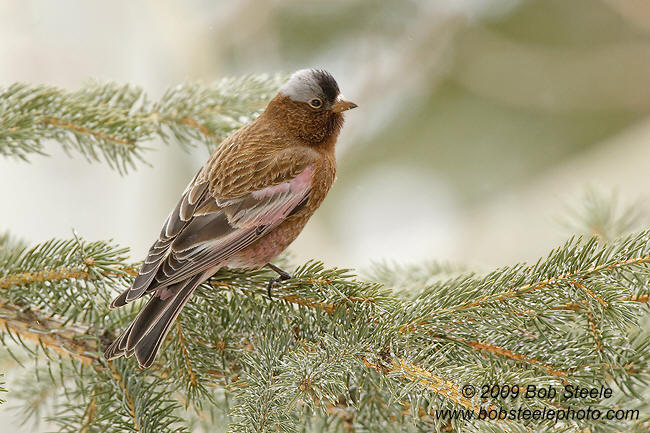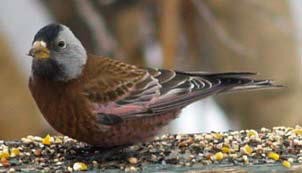[Originally appeared in the Sierra Wave newsletter, Vol. 27, No. 4, Mar-Apr 2009 – click here for original with photos]

Gray-crowned Rosy-Finch, Photo by Bob Steele
Independent birders and professional bird tours come to Inyo County annually to see the special birds that occur here. One such magnet is a small black, gray, and brown bird that is splashed with bright pink, the Gray-crowned Rosy-Finch. The premier destination for a first-hand experience with these unique and colorful birds is nationally renowned Aspendell, which has provided first-ever views, or “lifers,” to untold numbers of birders. The attraction is the bird feeders that residents hang and luckily they are gracious in sharing their birds with visitors from all over the world. The best time to see rosy-finches is after a heavy snow storm between November and April, which covers the food supply higher up in the mountains and turns the feeders into gathering places for hundreds of birds, mostly rosy-finches. Without a deep snow one is lucky to see more than just a few birds on a visit but they have been seen in Summer. Some visitors even pay for the privilege of seeing these birds by bringing bags of seed in exchange for permission to invade private property!

Sierra Nevada Rosy-Finch, Photo by Tom Heindel
Four sub-species of Gray-crowned Rosy-Finches have been documented for Inyo County. The Sierra Nevada Rosy-Finch (Leucosticte tephrosticte dawsoni) breeds here and is the rosy-finch hikers, skiers, fishermen, and birders find in the high county during the Summer. Those who have summited Mt. Whitney often share their lunch with these beggers who will eat out of their hands! Breeders in the Sierra Nevada are known from as far south as the Cottonwood Lakes area and in the higher sections of the White Mountains. There are no breeding records for any of the other ranges east of the Sierra Nevada but in winter they disperse and have been reported from the Inyo Mountains and Panamint Range. Some of the winter records are from the lowlands such as Panamint Springs (D. D. McLean, Condor 71:433) and south to Galileo Hill Park near California City, Kern Co. (M.T. Heindel, No. Amer. Birds 53:107). Other lower-than-expected locations have been along the roadsides in the Owens Valley after snow plows remove the snow down to the ground which is embedded with seeds as well as at feeders in Bishop (K. Wilson), Fish Springs (T. Heindel), and Big Pine (T. & J. Heindel).

Hepburn’s Rosy-Finch, Photo by Sharon Ford
The three other races have been found here only in winter. The most often reported is Hepburn’s Rosy- Finch (L. t. littoralis) a breeder in central Alaska, Yukon, British Columbia, and south to Mt. Shasta. They are easily identified by the extensive gray on the sides of their faces and most winters a few are at Aspendell. The remaining two races are documented only by specimens and the racial differences may be too subtle to allow field identification since they look very much like dawsoni. Cassin’s Gray-crowned Rosy-Finch (L. t. tephrocotis) breeds in the Brook’s Range in Alaska, Yukon, British Columbia, and western Montana while the Wallowa Rosy-Finch (L. t. wallowa) breeds in northeastern Oregon. The only other rosy-finch that occurs in Inyo County is the Black Rosy-Finch for which there are just over a dozen records…but that is another story.
Tags: crow, finch, owl




